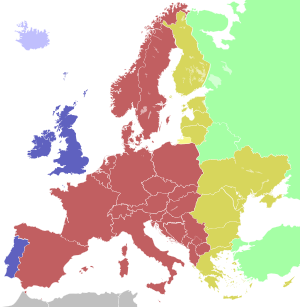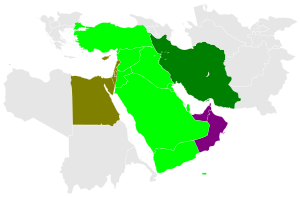Time in Turkey

| Western European Time / Greenwich Mean Time (UTC) | |
| Western European Time / Greenwich Mean Time (UTC) | |
| Western European Summer Time / British Summer Time / Irish Standard Time (UTC+1) | |
| Central European Time (UTC+1) | |
| Central European Summer Time (UTC+2) | |
| Eastern European Time / Kaliningrad Time (UTC+2) | |
| Eastern European Time (UTC+2) | |
| Eastern European Summer Time (UTC+3) | |
| Moscow Time / Turkey Time (UTC+3) |
▉▉▉ dark colours: summer time observed

Light colors ▉▉▉ standard time observed all year
Dark colors ▉▉ daylight saving time observed
Time in Turkey is given by UTC+03:00 year-round. This time is also called Turkey Time (TRT). The time is currently same as in the Arabia Standard Time and Moscow Time zone. Turkey Time was adopted by the Turkish Government on 8 September 2016.[1] It was also in use in the Turkish Republic of Northern Cyprus[2] until it reverted to EET in October 2017.[3]
History[]
Until 1927, "Turkish time" (or alla turca time or ezânî time) referred to the system of setting the clocks to 12:00 midnight at sunset.[4] This necessitated adjusting the clocks daily, although tower clocks were only reset two or three times a week,[5] and the precise time varied from one location to another depending on latitude and longitude.[4] The day was divided into two 12-hour periods, with the second 12:00 occurring at a "theoretical sunrise."[4][5] In practice, the Turkish railroads used both Turkish time (for public schedules) and eastern European time (for actually scheduling the trains), and government telegraph lines used St. Sophia time (i.e., Paris time + 1:47:32) for international telegrams.[5]
Until 2016, Turkey used Eastern European Time (EET) in the winter (UTC+02:00) and Eastern European Summer Time (EEST) (UTC+03:00) during the summer.[6] The date for transition between standard time and daylight saving time generally followed EU rules, but had variations in some years. In 2016, the decision to stay on UTC+03:00 year-round was enacted.[7] In October 2017, the Turkish government announced that starting 28 October 2018, the country would revert to EET,[8] but this decision was reversed in November 2017.[9] In October 2018, a presidential decree announced that UTC+03:00 would remain the year-round permanent time zone for the country.[10]
References[]
- ^ "Time and Date – Istanbul, Turkey".
- ^ "Turkish Time (TRT)".
- ^ "Saatler geri alınıyor!". Yeni Düzen. Retrieved 18 October 2017.
- ^ a b c Atilla Bir; Șinasi Acar; Mustafa Kaçar (2011). "The Clockmaker Family Meyer and Their Watch Keeping the alla turca Time". In Günergun, Feza; Raina, Dhruv (eds.). Science between Europe and Asia: Historical Studies on the Transmission, Adoption and Adaptation of Knowledge. Dordrecht: Springer. p. 126.
- ^ a b c "The Present Status of the Use of Standard Time". Publications of the United States Naval Observatory. 4 (2): G23. 1906.
- ^ "Time Zones – Istanbul". timeanddate.com. Retrieved 3 August 2016.
- ^ Turkey Stays on Daylight Saving Time for Good
- ^ "Türkiye'de saatler ne zaman ileri alınacak?". www.haberturk.com (in Turkish). Retrieved 28 March 2018.
- ^ "Yaz saati uygulaması sürekli hale geldi". www.hurriyet.com.tr (in Turkish). Retrieved 12 June 2018.
- ^ "Resmi Gazete'de yayımlandı: Flaş yaz saati kararı". Hürriyet (in Turkish). 2 October 2018. Archived from the original on 2 October 2018. Retrieved 2 October 2018.
- Time in Turkey
- Standards and measurement stubs
- Turkey stubs